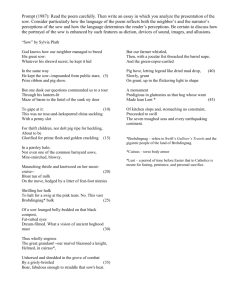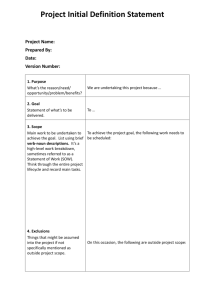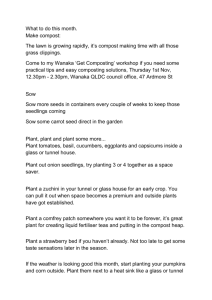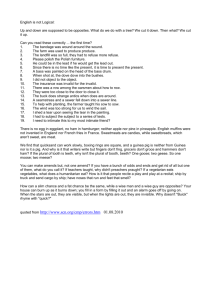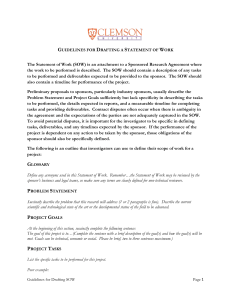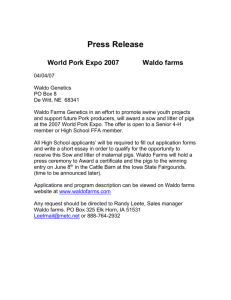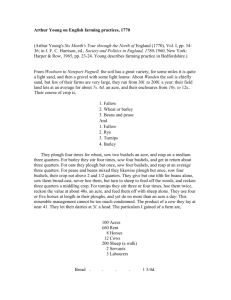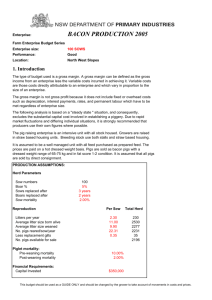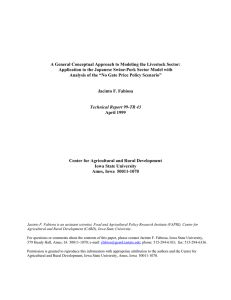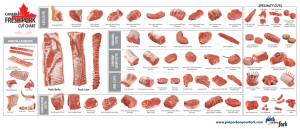Devolving Food Production to the Lowest Common Denominator
advertisement
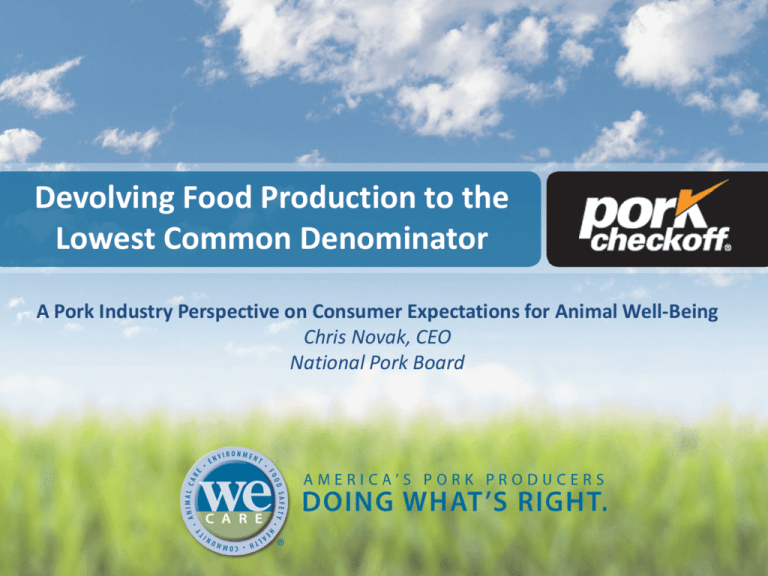
Devolving Food Production to the Lowest Common Denominator A Pork Industry Perspective on Consumer Expectations for Animal Well-Being Chris Novak, CEO National Pork Board Overview • The Danger of Dihydrogen Monoxidation • Pink Slime, Agent Orange Corn, & the Green Devolution • “Stalling” on a Slippery Slope • Preparing for the Next Wave • Hanging Together or Hanging Separately The Danger of Dihydrogen Monoxidation Key Findings of USFRA Consumer Research • While nearly all Americans agree that food production is important to the success of the country, they are split over whether it is going in the right or wrong direction • Consumers think about food production constantly, yet know very little about how food is brought to the dinner table • Overwhelmingly, farmers and ranchers share the same values as consumers on issues related to environmental stewardship and animal care • Though they think about food regularly, the researchers found that “consumers have become disconnected from their food.” Consumer Concerns About Agriculture 1-10 scale: 1 = extremely UNCOMFORTABLE with it 10 = extremely COMFORTABLE with it H2O Supplementing naturally occurring animal hormones Using dihydrogen monoxidization on crops and farm animals Using pesticides on crops Administering animal antibiotics Using genetically modified (GMOs) or biotech seeds Using fertilizers on crops Most Uncomf. (1-3) Influencers Uncomf. (1-3) “I’m not aware of this method” 55% 72% 2% 52% 53% 14% 49% 48% 59% 61% 1% 1% 43% 51% 2% 26% 31% - Pink Slime, Agent Orange Corn, & The Green Devolution A New Generation of Activist A New Generation of Attacks • • • • • • Demonstrations Social Media Corporate Outreach & Brand Attacks Lawsuits State & Local Ballot Initiatives Federal Legislative Initiatives The Real Agenda • “For modern animal agriculture, the less the consumer knows, the better.” – Dr. Michael Greger (HSUS) • “Slaughterhouses are a kind of Auschwitz.” – Dr. Holly Cheever (HSUS) • “Meat consumption shouldn’t be normal.” – Gene Baur (Farm Sanctuary) • “We need the poultry industry not to exist.” – Wenonah Hauter (Food and Water Watch) • “Agribusiness… they’re the radicals!” – U.S. Congressman Jim Moran (D-VA) • “Let’s hear about veganism as an alternative. Taking on meat should be the real war.” – Dr. James McWilliams (The Atlantic) Boiling the Frog • Reduce Supply • Increase Cost • Decrease Demand Fewer British Hogs & Hog Producers The Price to British Consumers Sources: BPEX, OECD Sow Housing: Estimating Industry-Wide Costs • Depends on Age of Facilities – No information – assume uniform distribution. – 25 year useful life, 1/25 of the barns are replaced each year. – Interpretation: If retrofit within 5 years, 20% of the industry will transition normally at end of life of facilities, 80% will be transitioning early, representing a capital opportunity loss. Costs = Capital + Permanent + Transition Aggregate Cost -- Capital Costs + Permanent Costs + 24-month Transition Percent Percent Decrease Increase in in Industry Mkt Hog NPVd Cost 2400 Sow Three Cycle NPVa 1200 Sow Three Cycle NPVa Total Industry Cost Retrofit Barns to Drop Feed $ 2,884,210,417 $ 1,637,154,971 $ 4,521,365,389 -100% 25.0% Build New Drop Feed $ 3,303,100,998 $ 1,826,565,552 $ 5,129,666,550 -113% 28.3% Build New ESF Feed $ 2,603,144,889 $ 1,403,147,158 $ 4,006,292,047 -88% 22.1% Retrofit Barns to Free-Stall $ 3,900,986,414 $ 2,199,416,921 $ 6,100,403,335 -135% 33.7% Build New Free-Stall $ 3,668,433,543 $ 2,028,588,996 $ 5,697,022,539 -126% 31.5% Industry Level Total Impact • Best Case = Loss of $1.239 billion – Retrofit barns to Drop Feed, Small Pens – No productivity hits or added costs. • Worst Case = $6.100 billion loss – Retrofit to Free Access Stalls – Added permanent costs – Labor – 2-year transition with -10% productivity hit “Stalling” on a Slippery Slope The Castration Scenario • Voluntary 2018 ban in Europe on piglet castration • Use of anesthesia or/and analgesia as of 2012 • Prominent US animal welfare specialist advocating vaccination as alternative • Economic incentive for integrated companies to use alternative approach • Activist videos & petition campaign beginning in US The Realities • No topical analgesics approved by FDA in US • Unsubstantiated reports of increased piglet mortality in countries anesthetizing piglets prior to castration • US consumer & food chain acceptance of vaccination alternative is questionable given existing consumer market research • Semen sexing and other technologies not available in the near-term • Non-castrate boars have significant economic & sustainability impact on food chain The Implication • 110 million market hogs X 50%= 55 million boars • Current market weight 280 pounds • 15.4 billion pounds live weight • Move to non-castrates requires marketing @180 lbs • 55 million boars X 180 pounds=9.9 billion pounds • Result: 18 % reduction in total pork supplies or a need to produce 23 million more animals Preparing for the Next Wave Pork Forum Resolution—Sow Housing • Fund additional research that optimizes sow housing system types and enables producers to make informed sow housing decisions to continually improve their farms • Provide pork producers with the information and education they need to implement responsible sow housing on their farms • Ensure that customers understand the animal welfare, environmental and producer sustainability consequences of their marketing decisions. 22 Vulnerabilities: From a Food Companies Perspective? • • • • • • • 23 Castration Ractopamine Euthanasia Antibiotics Feedback Culls Injected Product Action Plan: Understanding Food Company Needs IDENTIFY biggest potential issues • Start broad • Focus where activists are • Look far ahead CONSUMER RESEARCH framing + language to successfully address these issues DELIVER results to customers for use in communication plans and talking points Research & Education • Key Research Focus – Housing system optimization – Determine ideal criteria for creating groups of sows • Key Education Focus – Update the 2002 Sow Housing Conversion Calculator – Develop educational materials for caretakers for managing animals in group housing. – Develop lender fact sheets that outline reasonable conversion costs and production outcomes. • Key Customer Focus – Sustainability & Economic Analysis on key vulnerabilities 25 Hanging Together or Hanging Separately Our Food Company Requests • Work with those of us who support your business mission and goals—not activists who are hostile to your shareholder and consumer interests • Reflect your commitment to improving animal welfare through investments in research and engagement with the industry & academic experts who understand the science • Be open to listening to producers—beyond your immediate suppliers—who will be effected by your decisions • Do your due diligence—evaluate the economic, scientific, consumer, and environmental consequences of your welfare decisions • Understand the long-term agenda Questions? Chris Novak, CEO National Pork Board CNovak@Pork.org Ph: 515-223-2600 This message funded by America’s Pork Checkoff Program.
